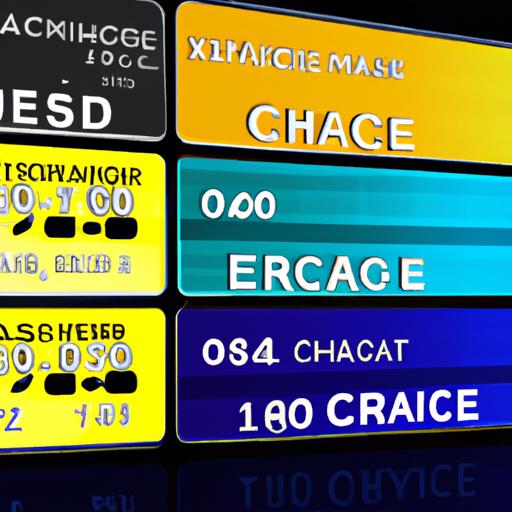
In today’s interconnected world, where we can make purchases from around the globe with just a few clicks, understanding exchange rates is crucial, especially when it comes to credit card transactions. One key player in this financial landscape is Chase and its credit card exchange rates. But what exactly does this entail?
When we talk about chase credit card exchange rates, we’re referring to the rate at which your purchases made in foreign currencies are converted to US dollars. This rate can have a significant impact on the final amount you pay, making it essential to grasp how it works and how it affects your transactions. So, let’s delve into the intricacies of Chase’s exchange rates and why it’s vital to have a solid understanding of them for your credit card dealings.
How Chase Determines Exchange Rates
Factors that Influence Chase’s Exchange Rates
Chase’s exchange rates are influenced by various factors that impact the global currency market. These factors include economic indicators, political events, market speculation, and central bank policies. Understanding how these elements come together can give you insight into why Chase’s exchange rates fluctuate and how they are determined.
One significant factor is the current market exchange rate between the foreign currency and the US dollar. Chase may also consider its operational costs, such as processing fees and hedging costs, when setting its exchange rates. By keeping an eye on these influencing factors, you can better predict and navigate Chase’s exchange rate fluctuations.
Comparison of Chase’s Rates with Other Credit Card Companies
It’s essential to compare Chase’s exchange rates with those of other credit card companies to ensure you’re getting the best deal. Different companies may offer varying rates, fees, and benefits for international transactions. By evaluating and contrasting Chase’s rates with its competitors, you can make informed decisions about which credit card to use for your foreign purchases. This comparison can help you save money and maximize the value of your transactions.
Benefits of Using Chase Credit Card for International Transactions
Lower Foreign Transaction Fees
When it comes to using your Chase credit card for international transactions, one of the standout benefits is the lower foreign transaction fees compared to other credit card providers. With reduced fees, you can save money on each purchase made overseas, making your international travel or online shopping experiences more cost-effective and efficient.
Competitive Exchange Rates
Chase offers competitive exchange rates for its credit card users, ensuring that you get a fair deal when converting foreign currency to US dollars. By taking advantage of these favorable rates, you can maximize your spending power and make the most out of your international purchases without worrying about excessive fees or hidden charges.
Rewards Program for International Purchases
In addition to lower transaction fees and competitive exchange rates, Chase also offers a rewards program tailored to international purchases. By using your Chase credit card for transactions abroad, you can earn rewards points or cashback, allowing you to benefit even further from your international spending. This incentive adds an extra layer of value to your credit card usage and enhances your overall financial experience when traveling or shopping internationally.
Tips for Maximizing Chase Credit Card Exchange Rates
Timing of Transactions to Take Advantage of Favorable Rates
When it comes to maximizing your Chase credit card exchange rates, timing is key. Exchange rates fluctuate constantly, so keeping an eye on market trends can help you identify when rates are favorable. By strategically planning your international transactions during times of stronger exchange rates, you can potentially save money on your purchases.
Avoiding Dynamic Currency Conversion
One common pitfall to watch out for when using your Chase credit card abroad is dynamic currency conversion. This option, offered by merchants, allows you to pay in your home currency rather than the local currency. However, this convenience often comes at a cost, as merchants may apply unfavorable exchange rates. Opting to pay in the local currency instead can help you avoid these additional fees and potentially secure a better exchange rate.
Using Chase’s Online Tools to Monitor Exchange Rates
To stay informed about current exchange rates and make informed decisions, take advantage of Chase’s online tools. These resources can provide real-time updates on currency values, allowing you to track fluctuations and choose the optimal time to make your transactions. By staying proactive and leveraging these tools, you can make the most of your Chase credit card exchange rates and optimize your international purchases.
Potential Risks of Using Chase Credit Card for Foreign Transactions
Fluctuations in Exchange Rates
One of the primary risks of using your Chase credit card for foreign transactions is the volatility of exchange rates. Exchange rates can fluctuate rapidly, meaning that the amount you ultimately pay in US dollars may vary from the initial estimate at the time of purchase. This unpredictability can result in unexpected costs, making it essential to monitor exchange rates closely when making international transactions.
Additional Fees for Cash Advances or ATM Withdrawals
In addition to exchange rate fluctuations, using your Chase credit card for cash advances or ATM withdrawals overseas may incur additional fees. These fees can add up quickly and significantly impact the overall cost of your transaction. It’s crucial to be aware of these potential charges and consider alternative payment methods to avoid unnecessary expenses while traveling abroad.
Fraud Protection Measures for International Purchases
While Chase offers robust fraud protection measures for international purchases, there is still a risk of unauthorized transactions when using your credit card overseas. It’s essential to notify Chase of your travel plans to ensure that your card is not flagged for suspicious activity. Additionally, monitoring your account regularly for any unauthorized charges can help mitigate the risks associated with fraudulent transactions.
Conclusion
In conclusion, navigating the world of Chase credit card exchange rates is a vital aspect of managing your finances and making informed decisions when it comes to international transactions. By understanding how Chase determines its rates, the benefits and risks of using your Chase credit card for foreign purchases, and tips for maximizing your exchange rate potential, you can make the most of your financial resources while traveling or shopping internationally.
Remember, staying informed and proactive about exchange rates can help you save money, earn rewards, and avoid unnecessary fees. By leveraging the tools and resources provided by Chase, as well as following best practices for international transactions, you can ensure a smooth and cost-effective experience when using your Chase credit card abroad. So, next time you’re planning a trip or making a purchase in a foreign currency, keep these insights in mind to make the most of your Chase credit card exchange rates.

